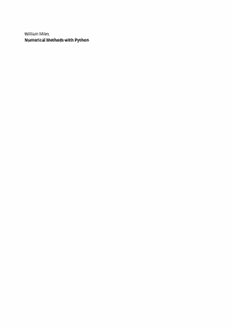
Numerical Methods with Python: for the Sciences PDF
Preview Numerical Methods with Python: for the Sciences
WilliamMiles NumericalMethodswithPython Also of Interest NumericalAnalysisonTimeScales SvetlinG.GeorgievandInciM.Erhan,2022 ISBN978-3-11-078725-2,e-ISBN(PDF)978-3-11-078732-0 AdvancedMathematics AnInvitationinPreparationforGraduateSchool PatrickGuidotti,2022 ISBN978-3-11-078085-7,e-ISBN(PDF)978-3-11-078092-5 QuantumInformationTheory ConceptsandMethods JosephM.Renes,2022 ISBN978-3-11-057024-3,e-ISBN(PDF)978-3-11-057025-0 Multi-levelMixed-IntegerOptimization ParametricProgrammingApproach StylianiAvraamidou,EfstratiosPistikopoulos,2022 ISBN978-3-11-076030-9,e-ISBN(PDF)978-3-11-076031-6 AutomataTheoryandFormalLanguages WladyslawHomendaandWitoldPedrycz,2022 ISBN978-3-11-075227-4,e-ISBN(PDF)978-3-11-075230-4 GeometryandDiscreteMathematics ASelectionofHighlights BenjaminFine,AnjaMoldenhauer,GerhardRosenberger, AnnikaSchürenber,LeonardWienke,2022 ISBN978-3-11-074077-6,e-ISBN(PDF)978-3-11-074078-3 William Miles Numerical Methods with Python � for the Sciences MathematicsSubjectClassification2010 Primary:34-04,35-04;Secondary:92C45,92D25,34C28,37D45 Author WilliamMiles,PhD StetsonUniversity DepartmentofMathematicsandComputerScience 421N.WoodlandBlvd. Deland32723 FLUSA wmiles@stetson.edu ISBN978-3-11-077645-4 e-ISBN(PDF)978-3-11-077664-5 e-ISBN(EPUB)978-3-11-077693-5 LibraryofCongressControlNumber:2022950763 BibliographicinformationpublishedbytheDeutscheNationalbibliothek TheDeutscheNationalbibliothekliststhispublicationintheDeutscheNationalbibliografie; detailedbibliographicdataareavailableontheInternetathttp://dnb.dnb.de. ©2023WalterdeGruyterGmbH,Berlin/Boston Coverimage:E.K.Miles Typesetting:VTeXUAB,Lithuania Printingandbinding:CPIbooksGmbH,Leck www.degruyter.com � ThisbookisdedicatedtoAndiandEmmy.Tohavetheminmylifeisablessingbeyond measure. Acknowledgment IthankWilliamWoodandSammiSmithfortakingthetimetoreadandeditlargesec- tionsofthetext.Ialsothankmystudents,HalleBlock,EmilyMehigan,andCaseyRamey, foralertingmeoferrorsastheytookthecourse. https://doi.org/10.1515/9783110776645-201 Contents Acknowledgment�VII 1 Introduction�1 2 ThebasicoperationsinPython�3 2.1 ObtainingPython�3 2.2 Addition,subtraction,multiplication,anddivision�3 2.3 Powers�8 2.4 Displayingoutput�8 2.5 Exercises�10 3 Functions�11 3.1 Exponentials,logs,andtrigfunctions�11 3.2 Variables�13 3.3 Definingandusingmathematicalfunctions�17 3.4 Gettinginputfromthekeyboard�19 3.5 Graphingfunctions�20 3.6 Exercises�38 4 Matrices,vectors,andlinearsystems�41 4.1 Matriceswithnumpy�41 4.1.1 Additionandsubtraction:A±B�44 4.1.2 Component-wisemultiplication:A∗B�46 4.1.3 Component-wisedivision:A/B�47 4.1.4 Scalarmultiplication:cA�48 4.1.5 Standardmatrixmultiplication�49 4.2 Matrixinversion�51 4.2.1 Theidentitymatrix�52 4.2.2 Theinverseofamatrix�53 4.3 Linearsystems�57 4.4 Exercises�68 5 Iteration�71 5.1 Findingroots:thebisectionmethod�71 5.2 Euler’smethodfordifferentialequations�80 5.2.1 Systemsofdifferentialequationsandhigher-orderdifferential equations�91 5.2.2 Interpolation—usingtheapproximations�99 5.3 Exercises�101 X � Contents 6 Statistics�103 6.1 Filehandling�103 6.2 Descriptivestatistics�118 6.3 Probability�123 6.3.1 Numericalintegration�125 6.4 Confidenceintervalforthemeanofapopulation�132 6.5 Hypothesistesting�140 6.6 Comparinggroups�147 6.6.1 Comparingmeansoftwogroups�147 6.6.2 Comparingmeansofmorethantwogroups�152 6.7 Exercises�157 7 Regression�161 7.1 Linearregression�161 7.1.1 Correlation�170 7.1.2 Multiplelinearregression�171 7.2 Logisticregression�178 7.2.1 Digitrecognitionmodel�186 7.3 Neuralnetworks�193 7.4 Exercises�206 A Pythoncode�209 A.1 Chapter2code�209 A.2 Chapter3code�209 A.3 Chapter4code�216 A.4 Chapter5code�221 A.5 Chapter6code�228 A.6 Chapter7code�240 B Solutions�249 Index�313 IndexofPythonCommands�315
